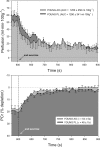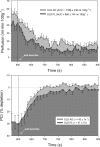Antioxidants and aging: NMR-based evidence of improved skeletal muscle perfusion and energetics
- PMID: 19767527
- PMCID: PMC2781367
- DOI: 10.1152/ajpheart.00709.2009
Antioxidants and aging: NMR-based evidence of improved skeletal muscle perfusion and energetics
Abstract
We sought to examine the potential role of oxidative stress on skeletal muscle function with advancing age. Nuclear magnetic resonance (NMR) was employed to simultaneously assess muscle perfusion (arterial spin labeling) and energetics ((31)P NMR spectroscopy) in the lower leg of young (26 + or - 5 yr, n = 6) and older (70 + or - 5 yr, n = 6) healthy volunteers following the consumption of either placebo (PL) or an oral antioxidant (AO) cocktail (vitamins C and E and alpha-lipoic acid), previously documented to decrease plasma free radical concentration. NMR measurements were made during and after 5 min of moderate intensity (approximately 5 W) plantar flexion exercise. AO administration significantly improved end-exercise perfusion (AO, 50 + or - 5, and PL, 43 + or - 4 ml x 100 g(-1) x min(-1)) and postexercise perfusion area under the curve (AO, 1,286 + or - 236, and PL, 866 + or - 144 ml/100 g) in older subjects, whereas AO administration did not alter hemodynamics in the young group. Concomitantly, muscle oxidative capacity (time constant of phosphocreatine recovery, tau) was improved following AO in the older (AO, 43 + or - 1, and PL, 51 + or - 7 s) but not the young (AO, 54 + or - 5, and PL, 48 + or - 7 s) group. These findings support the concept that oxidative stress may be partially responsible for the age-related decline in skeletal muscle perfusion during physical activity and reveal a muscle metabolic reserve capacity in the elderly that is accessible under conditions of improved perfusion.
Figures




Similar articles
-
Oxidative stress and COPD: the effect of oral antioxidants on skeletal muscle fatigue.Med Sci Sports Exerc. 2013 Jul;45(7):1235-43. doi: 10.1249/MSS.0b013e3182846d7e. Med Sci Sports Exerc. 2013. PMID: 23299763 Free PMC article. Clinical Trial.
-
A differing role of oxidative stress in the regulation of central and peripheral hemodynamics during exercise in heart failure.Am J Physiol Heart Circ Physiol. 2012 Nov 15;303(10):H1237-44. doi: 10.1152/ajpheart.00568.2012. Epub 2012 Sep 7. Am J Physiol Heart Circ Physiol. 2012. PMID: 22961867 Free PMC article. Clinical Trial.
-
Multiparametric NMR-based assessment of skeletal muscle perfusion and metabolism during exercise in elderly persons: preliminary findings.J Gerontol A Biol Sci Med Sci. 2009 Sep;64(9):968-74. doi: 10.1093/gerona/glp044. Epub 2009 Apr 17. J Gerontol A Biol Sci Med Sci. 2009. PMID: 19377015 Free PMC article.
-
Antioxidants: role of supplementation to prevent exercise-induced oxidative stress.Med Sci Sports Exerc. 1993 Feb;25(2):232-6. Med Sci Sports Exerc. 1993. PMID: 8450726 Review.
-
Effect of Physical Activity/Exercise on Oxidative Stress and Inflammation in Muscle and Vascular Aging.Int J Mol Sci. 2022 Aug 5;23(15):8713. doi: 10.3390/ijms23158713. Int J Mol Sci. 2022. PMID: 35955849 Free PMC article. Review.
Cited by
-
Oxidative stress and COPD: the effect of oral antioxidants on skeletal muscle fatigue.Med Sci Sports Exerc. 2013 Jul;45(7):1235-43. doi: 10.1249/MSS.0b013e3182846d7e. Med Sci Sports Exerc. 2013. PMID: 23299763 Free PMC article. Clinical Trial.
-
Nitric oxide, but not vasodilating prostaglandins, contributes to the improvement of exercise hyperemia via ascorbic acid in healthy older adults.Am J Physiol Heart Circ Physiol. 2010 Nov;299(5):H1633-41. doi: 10.1152/ajpheart.00614.2010. Epub 2010 Sep 3. Am J Physiol Heart Circ Physiol. 2010. PMID: 20817831 Free PMC article. Clinical Trial.
-
Using MRI to measure in vivo free radical production and perfusion dynamics in a mouse model of elevated oxidative stress and neurogenic atrophy.Redox Biol. 2019 Sep;26:101308. doi: 10.1016/j.redox.2019.101308. Epub 2019 Aug 21. Redox Biol. 2019. PMID: 31470261 Free PMC article.
-
Attenuated exercise induced hyperaemia with age: mechanistic insight from passive limb movement.J Physiol. 2010 Nov 15;588(Pt 22):4507-17. doi: 10.1113/jphysiol.2010.198770. Epub 2010 Sep 27. J Physiol. 2010. PMID: 20876201 Free PMC article.
-
Interleaved and simultaneous multi-nuclear magnetic resonance in vivo. Review of principles, applications and potential.NMR Biomed. 2022 Oct;35(10):e4735. doi: 10.1002/nbm.4735. Epub 2022 Apr 27. NMR Biomed. 2022. PMID: 35352440 Free PMC article. Review.
References
-
- Arosio E, De Marchi S, Zannoni M, Prior M, Lechi A. Effect of glutathione infusion on leg arterial circulation, cutaneous microcirculation, and pain-free walking distance in patients with peripheral obstructive arterial disease: a randomized, double-blind, placebo-controlled trial. Mayo Clin Proc 77: 754–759, 2002 - PubMed
-
- Beere PA, Russell SD, Morey MC, Kitzman DW, Higginbotham MB. Aerobic exercise training can reverse age-related peripheral circulatory changes in healthy older men. Circulation 100: 1085–1094, 1999 - PubMed
-
- Carlier PG, Bertoldi D. In vivo functional NMR imaging of resistance artery control. Am J Physiol Heart Circ Physiol 288: H1028–H1036, 2005 - PubMed
-
- Carlier PG, Brillault-Salvat C, Giacomini E, Wary C, Bloch G. How to investigate oxygen supply, uptake, and utilization simultaneously by interleaved NMR imaging and spectroscopy of the skeletal muscle. Magn Reson Med 54: 1010–1013, 2005 - PubMed
Publication types
MeSH terms
Substances
Grants and funding
LinkOut - more resources
Full Text Sources
Medical
Miscellaneous

